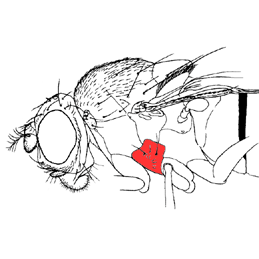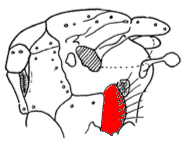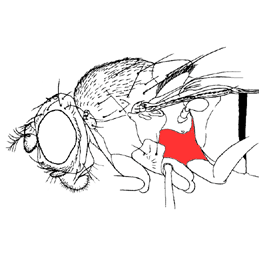|
Users Online
· Guests Online: 38
· Members Online: 0
· Total Members: 5,078
· Newest Member: defanti
Forum Threads
Theme Switcher
Last Seen Users
Latest Photo Additions
|
Terms Infusion (Glossary) - v3.10
|
I |
| instar |
See: larval instar![header=[larval instar] body=[One of the developmental stages of the larva, between successive moults (the term instar can also be used to describe any developmental stage including egg, pupa or imago, so must not be used without stating which part of the life cycle is being referred to, i.e., always write larval instar even though the terms egg instar, pupal instar, imago instar are very rare). The number of larval instars is six or seven in black flies (Simuliidae) and four in most other Nematocera. Along the second line of evolution of flies, Brachycera have from five to eight instars while the maggots of the most advanced flies (Cyclorrhapha) have only three. One or two species have no moults. Sometimes moults occur before the larva hatches from the egg. Muscidae, for example, are arranged in three groups according to whether they are trimorphic (i.e., have three free larval instars), dimorphic (i.e., pass the first instar in the egg, have two free larval instars), or monomorphic (i.e., pass the first two instars in the egg, have one free larval instar). Monomorphic larvae are always predatory; trimorphic and dimorphic larvae feed first on decaying matter (are saprophagous), but they may or may not be predatory in their final instar.<br />
Recommended literature: Smith, K.V.G., 1989. An introduction to the immature stages of British flies. Diptera larvae, with notes on eggs, puparia and pupae. - Handbooks for the Identification of British Insects 10(14): 1-280. As an excellent reference with keys to suborders, families, subfamilies and genera.<br /><img src='../../infusions//terms/images/no_image.gif' style='vertical-align:middle;' />] delay=[0] fade=[on]](../../infusions/terms/images/help.gif) | | invasive species |
A species that is expanding its range, often but not always detrimentally (causing 'harm'). Compare with adventive species![header=[adventive species] body=[A species that has arrived in the geographical area specified from somewhere else by any means (for instance with cargo). Compare with invasive species.<br />
<br />
<br /><img src='../../infusions//terms/images/no_image.gif' style='vertical-align:middle;' />] delay=[0] fade=[on]](../../infusions/terms/images/help.gif) . .
Links: http://en.wikiped...ve_species; http://www.invasi....cfm?id=58 (Invasive and exotic Diptera on www.invasive org).
|
J |
| jizz |
Jizz is the 'je ne sais quoi' of a fly's being, the not easily defined mix of characters which identify a taxon.
This is the concept of gestalt and the family species is a gestalt entity. A gestalt entity is a physical, biological, psychological, or symbolic configuration or pattern of elements, so unified as a whole that its properties cannot be derived from a simple summation of its parts.
|
K |
| katepisternum |
Ventral part of the lateral plate of the thorax that is associated with the second segment that originally formed the thorax.
Image given: http://www.dgrc.k...pleura.gif | 
| | key |
| An identification key, also known as a dichotomous key, is a method of deducing the name of a species. It usually works by offering two (in a truely dichotomous key, sometimes more) alternatives at each juncture, and the choice of one of those alternatives determines the next step. A very common error in using a dichotomous key is the assumption that the correct identification is even included in that key. It is possible that a specimen cannot be identified with a particular key, yet the key will lead the user to an end that appears to be "answer". For this reason, comparing the specimen with a more detailed description is vitally important: a dichotomous key alone cannot be used to identify specimens, unless the specimens are known in advance to be included within the key. See http://en.wikiped...se_of_Keys for further comments. See also the Weblinks Section Online keys". | | kissybug |
| love bug (synonym) | | kleptoparasitism |
Literally, parasitism by theft. A form of feeding where one animal takes prey that another has caught, killed, or otherwise prepared it for instance as a stored food provision.
Links: http://en.wikiped...parasitism; Sivinski, J., S. Marshall & E. Petersson, 1999. Kleptoparasitism and phoresy in the Diptera. - Florida Entomologist 82: 179-197 (download). |
L |
| larval instar |
One of the developmental stages of the larva, between successive moults (the term instar can also be used to describe any developmental stage including egg, pupa or imago, so must not be used without stating which part of the life cycle is being referred to, i.e., always write larval instar even though the terms egg instar, pupal instar, imago instar are very rare). The number of larval instars is six or seven in black flies (Simuliidae) and four in most other Nematocera. Along the second line of evolution of flies, Brachycera have from five to eight instars while the maggots of the most advanced flies (Cyclorrhapha) have only three. One or two species have no moults. Sometimes moults occur before the larva hatches from the egg. Muscidae, for example, are arranged in three groups according to whether they are trimorphic (i.e., have three free larval instars), dimorphic (i.e., pass the first instar in the egg, have two free larval instars), or monomorphic (i.e., pass the first two instars in the egg, have one free larval instar). Monomorphic larvae are always predatory; trimorphic and dimorphic larvae feed first on decaying matter (are saprophagous), but they may or may not be predatory in their final instar.
Recommended literature: Smith, K.V.G., 1989. An introduction to the immature stages of British flies. Diptera larvae, with notes on eggs, puparia and pupae. - Handbooks for the Identification of British Insects 10(14): 1-280. As an excellent reference with keys to suborders, families, subfamilies and genera. | | lectotype |
A syntype![header=[syntype] body=[Each specimen of a type series from which neither a holotype nor a lectotype has been designated. The syntypes collectively constitute the name-bearing type. (From the Glossary of the International Code of Zoological Nomenclature) (http://www.diptera.info/weblinks.php?cat_id=5&weblink_id=72).<br /><img src='../../infusions//terms/images/no_image.gif' style='vertical-align:middle;' />] delay=[0] fade=[on]](../../infusions/terms/images/help.gif) designated as the single name-bearing type specimen subsequent to the establishment of a nominal species or subspecies. (From the Glossary of the International Code of Zoological Nomenclature). designated as the single name-bearing type specimen subsequent to the establishment of a nominal species or subspecies. (From the Glossary of the International Code of Zoological Nomenclature). | | leg setae |
These are setae![header=[setae] body=[seta<br /><img src='../../infusions//terms/images/no_image.gif' style='vertical-align:middle;' />] delay=[0] fade=[on]](../../infusions/terms/images/help.gif) placed on the surface of a leg. Often setae placed on femora or tibiae have diagnostic value, but there can also be setae on other parts of the legs. The leg is divided into eight imaginary planes: dorsal placed on the surface of a leg. Often setae placed on femora or tibiae have diagnostic value, but there can also be setae on other parts of the legs. The leg is divided into eight imaginary planes: dorsal![header=[dorsal] body=[1. Located on the dorsum. For legs this means that these are considered as if they were in the position as given in the illustration. So, even if a leg is pointing upwards in a specimen, one should image that the leg was positioned in a horizontal plane, perpendicular to the body axis.<br />
<br />
2. Located in a more position towards the dorsum. For example, a seta can be located dorsal to another seta.<br />
<br />
Opposite: ventral.<br /><img src='http://www.diptera.info/images/orientation.gif' style='vertical-align:middle;' />] delay=[0] fade=[on]](../../infusions/terms/images/help.gif) , posterodorsal , posterodorsal![header=[posterodorsal] body=[Located in the plane between posterior and dorsal.<br /><img src='http://www.diptera.info/images/orientation.gif' style='vertical-align:middle;' />] delay=[0] fade=[on]](../../infusions/terms/images/help.gif) , posterior , posterior![header=[posterior] body=[Located in the direction of the apex of the abdomen when considering a position along the longitudinal axis. Even a structure near the head has a side that is directed towards apex of the abdomen. Likewise, every structure perpendicular to the longitudinal axis of the body (leg, wing) has a side that is directed towards the apex of the abdomen.<br /><img src='http://www.diptera.info/images/orientation.gif' style='vertical-align:middle;' />] delay=[0] fade=[on]](../../infusions/terms/images/help.gif) , posteroventral , posteroventral![header=[posteroventral] body=[Located in the plane between posterior and ventral.<br /><img src='http://www.diptera.info/images/orientation.gif' style='vertical-align:middle;' />] delay=[0] fade=[on]](../../infusions/terms/images/help.gif) , ventral , ventral![header=[ventral] body=[1. Located on the venter. For legs this means that these are considered as if they were in the position as given in the illustration. So, even if a leg is pointing upwards in a specimen, one should image that the leg was positioned in a horizontal plane, perpendicular to the body axis.<br />
<br />
2. Located in a more position towards the venter. For example, a seta can be located ventral to another seta.<br />
<br />
Opposite: dorsal.<br /><img src='http://www.diptera.info/images/orientation.gif' style='vertical-align:middle;' />] delay=[0] fade=[on]](../../infusions/terms/images/help.gif) , anteroventral , anteroventral![header=[anteroventral] body=[Located in the plane between anterior and ventral.<br /><img src='http://www.diptera.info/images/orientation.gif' style='vertical-align:middle;' />] delay=[0] fade=[on]](../../infusions/terms/images/help.gif) , anterior , anterior![header=[anterior] body=[Located in the direction of the head when considering a position along the longitudinal axis. Even a structure near the apex of the abdomen has a side that is directed towards the head end and another that is directed towards the apex of the abdomen. Likewise, every structure perpendicular to the longitudinal axis of the body (leg, wing) has a side that is directed towards the head. <br />
<br />
<br /><img src='http://www.diptera.info/images/orientation.gif' style='vertical-align:middle;' />] delay=[0] fade=[on]](../../infusions/terms/images/help.gif) , and anterodorsal , and anterodorsal![header=[anterodorsal] body=[Located in the plane between anterior and dorsal.<br /><img src='http://www.diptera.info/images/orientation.gif' style='vertical-align:middle;' />] delay=[0] fade=[on]](../../infusions/terms/images/help.gif) . The leg flexes in the dorsal-ventral plane and if the leg is rotated on the coxa this is the important fact and not the position of the leg relative to the whole fly. Twin rows of small dorsal setae running the length of the femur and tibia act as a guide in some flies. Presence, absence, number and relative size of leg setae may be very significant taxonomic characters in many Diptera. . The leg flexes in the dorsal-ventral plane and if the leg is rotated on the coxa this is the important fact and not the position of the leg relative to the whole fly. Twin rows of small dorsal setae running the length of the femur and tibia act as a guide in some flies. Presence, absence, number and relative size of leg setae may be very significant taxonomic characters in many Diptera. | | lesser dung flies |
Vernacular name used for the family Sphaeroceridae.
Links: http://en.wikiped...eroceridae. | | lesser house flies |
Vernacular name used for the family Fanniidae, more precisely for Fannia canicularis.
Links: http://en.wikiped.../Fanniidae.
| | little house flies |
| lesser house flies (synonym) | | love bug |
Vernacular name for Plecia nearctica Hardy, 1940 (Pleciidae s.str. or Bibionidae s.l.).
Also known as lovebug, kissybug, telephone bug, double-headed bug, and honeymoon fly.
Links: http://en.wikiped...i/Love_bug
| | lovebug |
| love bug (synonym) | | lower calypter |
| The proximal lobe of the posterobasal portion of the axillary membrane that joins the hind margin of the wing to the thorax is called the lower calypter. It begins as a narrow, membranous ligament arising from the furrow between the scutellum and the postnotum and ends where the more distal lobe, the upper calypter, folds sharply over it. |
M |
| Malaise trap |
A large, tent-like structure used for trapping flying insects particularly hymenoptera and diptera. It is a tent-like structure made of a material such as terylene netting and can be in various colours. Insects fly into the tent wall and those with a habits of moving upwards on hitting an onbstruction are funnelled into a collecting vessel attached to the highest point.
The trap was developed by the Swedish entomologist René Malaise.
Links: http://en.wikiped...A9_Malaise (René Malaise), http://www.johnwh...s_trap.pdf (setup instructions), http://www.discov...final.html (calibration for biodiversity sampling, a proposal document) | | meral bristles |
The curved row of bristles on the meron (=hypopleuron). The meron is the triangular(ish) plate on the side of the thorax above and between the mid and hind coxae (the very basal segment of the legs). The presence of meral bristles distinguishes the Calliphoridae, Sarcophagidae, Rhinophoridae and Tachinidae (which have them) from the Muscidae, Scathophagidae, Anthomyiidae and Faniidae (which don't). The easiest way to find the meral bristles is to find the posterior thoracic spiracle, then look a little below and in front of it.
Links:
http://www.nku.ed...milies.htm First couplet. | 
| | meron |
Ventral part of the lateral plate of the thorax that is associated with the third segment that originally formed the thorax.
Image given: http://www.dgrc.k...pleura.gif | 
| | mesolobus |
| cercal plate (synonym) |
|
|
| Date and time
Login
Not a member yet? Click here to register.
Forgotten your password? Request a new one here.
Temporary email?
Due to fact this site has functionality making use of your email address, any registration using a temporary email address will be rejected. Paul
Donate
Latest Articles
Syrph the Net
Those who want to have access to the Syrph the Net database need to sign the
License Agreement -
Click to Download
Public files of Syrph the Net can be downloaded HERE
Last updated: 25.08.2011
Shoutbox
You must login to post a message.
|












![header=[larval instar] body=[One of the developmental stages of the larva, between successive moults (the term instar can also be used to describe any developmental stage including egg, pupa or imago, so must not be used without stating which part of the life cycle is being referred to, i.e., always write larval instar even though the terms egg instar, pupal instar, imago instar are very rare). The number of larval instars is six or seven in black flies (Simuliidae) and four in most other Nematocera. Along the second line of evolution of flies, Brachycera have from five to eight instars while the maggots of the most advanced flies (Cyclorrhapha) have only three. One or two species have no moults. Sometimes moults occur before the larva hatches from the egg. Muscidae, for example, are arranged in three groups according to whether they are trimorphic (i.e., have three free larval instars), dimorphic (i.e., pass the first instar in the egg, have two free larval instars), or monomorphic (i.e., pass the first two instars in the egg, have one free larval instar). Monomorphic larvae are always predatory; trimorphic and dimorphic larvae feed first on decaying matter (are saprophagous), but they may or may not be predatory in their final instar.<br />
Recommended literature: Smith, K.V.G., 1989. An introduction to the immature stages of British flies. Diptera larvae, with notes on eggs, puparia and pupae. - Handbooks for the Identification of British Insects 10(14): 1-280. As an excellent reference with keys to suborders, families, subfamilies and genera.<br /><img src='../../infusions//terms/images/no_image.gif' style='vertical-align:middle;' />] delay=[0] fade=[on]](../../infusions/terms/images/help.gif)


